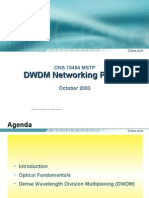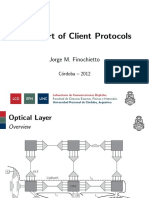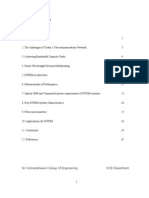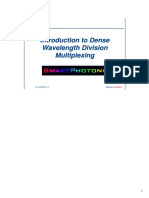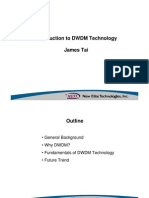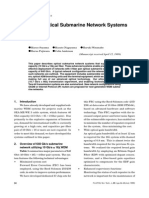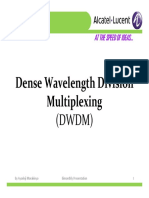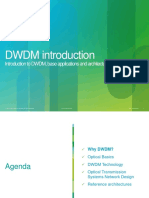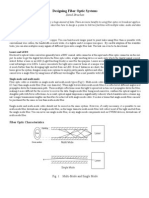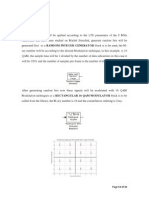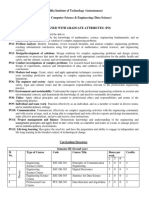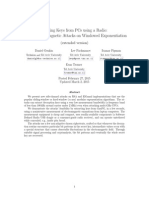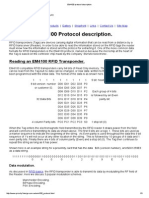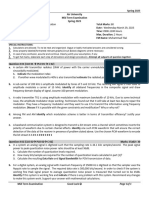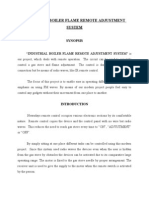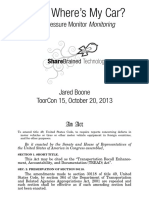Making OSNR Measurements in A Modulated DWDM Signal Environment
Making OSNR Measurements in A Modulated DWDM Signal Environment
Uploaded by
hasCopyright:
Available Formats
Making OSNR Measurements in A Modulated DWDM Signal Environment
Making OSNR Measurements in A Modulated DWDM Signal Environment
Uploaded by
hasOriginal Title
Copyright
Available Formats
Share this document
Did you find this document useful?
Is this content inappropriate?
Copyright:
Available Formats
Making OSNR Measurements in A Modulated DWDM Signal Environment
Making OSNR Measurements in A Modulated DWDM Signal Environment
Uploaded by
hasCopyright:
Available Formats
Making OSNR Measurements
In a Modulated DWDM
Signal Environment
Making OSNR Measurements in a
Modulated DWDM Signal Environment
Jack Dupre
Jim Stimple
Making OSNR measurements
in a modulated DWDM
signal environment
May 2001
In a DWDM spectrum, it is desirable to measure the optical signal-to-noise
ratio (OSNR) of each channel in order to gauge signal quality. A
standardized definition and test method is described.
With higher modulation rates and narrower channel spacing, the
modulation sidebands from adjacent channels interfere and limit the ability
to measure the noise level between channels. Increasing the resolution of
the optical spectrum analyzer does not affect this limitation. This paper
provides simulations and actual measurements demonstrating the OSNR
limit for 50-GHz channel spacing and modulation rates of 2.5 and 10 Gb/s.
2-1
Making OSNR Measurements in a
Modulated DWDM Signal Environment
Signal impairments in a DWDM transport
network can come from a variety of sources
Single-channel interface
multichannel interface
MUX
OA
OA
OADM
OA
OA
OA
DEMUX
T
r
...
...
Fiber loss
Optical amplifier ASE Can be deduced from optical measurements
Optical crosstalk
Fiber nonlinearities
Chromatic dispersion
Polarization-mode dispersion
Waveshape distortion
Require per-channel signal measurements
In the unrelenting move toward all-optical networking, there are increasingly larger
segments of the network in which there is no optical- to-electrical conversion. Here
is shown an example of such a network section. Interfaces to this network section
are standardized single-channel interfaces. As the DWDM signals propagate
through the network, signal impairments that impact overall system quality can
occur.
At the multichannel optical interfaces within such a network segment, it is
desirable to measure parameters that provide information about signal quality.
Such parameters are necessary in the manufacture of network elements, the
installation of the network, and in performance monitoring of the operating
network.
Ideally, such parameters would directly correspond to the bit error ratio (BER) of
each channel of a multichannel carrier at the particular optical interface. Related
parameters such as Q-factor or optical eye patterns would provide similar
information and could be correlated to per-channel BER. However, it is difficult to
obtain access to these parameters at a multichannel interface point. It is necessary
to demultiplex the potentially large number of channels and make BER, Q-factor, or
eye-diagram measurements on a per-channel basis.
In contrast, useful information about the optical properties of the multichannel
carrier is readily obtained by measuring the optical spectrum. Wavelength-resolved
signal and noise levels provide information on signal level, signal wavelength, and
amplified spontaneous emission (ASE) for each channel.
2-2
Making OSNR Measurements in a
Modulated DWDM Signal Environment
OSNR in a transport network is dependent
upon optical amplifier noise figure
single span
Span loss
L (dB)
Signal-spontaneous noise figure*
F (dB)
Pout
ASE(
)
OA
N spans
L (dB)
F (dB)
h is Plancks constant
is optical frequency
r is the reference optical bandwidth
where
F (dB)
F (dB)
L (dB)
L (dB)
OA
OSNR = Pout - L - F - 10 Log (h
r)
OA
OA
Pout
ASE()
OSNR = Pout - L - F - 10 Log (N) - 10 Log (h
r )
* Signal-spontaneous noise figure is defined in IEC Publication 61290-3, Basic specification for
optical fibre amplifiers test methods Part 3: Test methods for noise figure parameters
For a transport network, the OSNR can be calculated for given system
parameters including span loss and optical amplifier gain and noise figure.
It is therefore a useful parameter to determine if a system is performing to
its designed performance.
2-3
Making OSNR Measurements in a
Modulated DWDM Signal Environment
Optical signal-to-noise ratio (OSNR)
Useful to predict system impairment due to optical power and
optical amplifier gain and ASE
Optical power
missing channels
noise
Wavelength
A typical optical spectrum at a multichannel interface is shown here.
Important characteristics are:
(a) The channels are placed nominally on the grid defined by ITU G.692.
(b) Individual channels may be non-existent because it is a network
designed with optical add/drop demultiplexers or because particular
channels are out of service.
(c) Both channel power and noise power are a function of wavelength.
For calculating OSNR, the most appropriate noise power value is that at the
channel wavelength. However, with a direct spectral measurement, the
noise power at the channel wavelength is included in signal power and is
difficult to extract. An estimate of the channel noise power can be made by
interpolating the noise power value between channels.
2-4
Making OSNR Measurements in a
Modulated DWDM Signal Environment
OSNR Standardized Definition*
With an optical spectrum
analyzer, noise power is
interpolated at each channel
Ni =
P i + Ni
N( i- )+N( i+)
2
N ( i - )
OSNR = 10Log
Ni
N ( i + )
Pi
+ 10Log Bm
Ni
Br
* TIA/EIA-526-19, OFSTP-19, Optical Signal-to-Noise Ratio Measurement Procedures for
Dense Wavelength-Division Multiplexed Systems
In the figure:
Pi is the optical signal power in watts at the i-th channel.
Ni is the interpolated value of noise power in watts measured in noise
equivalent bandwidth, Bm, at the i-th channel.
Dl is the interpolation offset equal to or less than one-half the ITU grid
spacing,
Br is the reference optical bandwidth. (The units for Bm and Br may be in
frequency or wavelength but must be consistent.) Typically, the reference
optical bandwidth is 0.1 nm.
Note that in the equation for OSNR, there is an adjustment to convert the
OSA measured value of noise to that in the reference bandwidth. Also, the
signal power is is obtained by subtracting the the measured noise value.
2-5
Making OSNR Measurements in a
Modulated DWDM Signal Environment
Modulated source spectral width can
cause an error in signal measurement
Power Envelope for
10 Gb/s 27-1 PRBS
0.06 nm
Resolution
Bandwidth
Shape
OSA resolution
bandwidth set
too narrow will
not capture all
source power
The spectral width of each channel is broadened from that of the CW laser
due to several causes:
(a) laser chirp
(b) intensity modulation for signal transmission
(c) modulation to suppress stimulated Broullion scattering (SBS).
(d) self-phase modulation (SPM)
For dense WDM systems in which external modulation is generally used,
laser chirp is not a factor. Broadening due to SBS suppression and SPM are
typically small compared to the broadening due to the signal modulation at
2.5-Gb/s and higher rates.
If the OSA resolution bandwidth is too narrow, the measured signal power
will be lower than the true signal power.
2-6
Making OSNR Measurements in a
Modulated DWDM Signal Environment
Wide RBW required to avoid errors in
signal measurement
10 Gbit/s NRZ Modulation 2
Amplitude Error dB
Amplitude Error dB
2.5 Gbit/s NRZ Modulation 1
~0.5 dB error
with 50 pm RBW
Resolution Bandwidth nm
~2.5 dB error
with 50 pm RBW
Resolution Bandwidth nm
1 Assumes 7.5-GHz
electrical and 0.36-nm
optical filtering with zero chirp.
2 Assumes 30-GHz
electrical and 0.64-nm
optical filtering with zero chirp.
Because a portion of the signal power is not captured by the OSA, an error
in the measured signal power occurs. These charts show the magnitude of
the error for 2.5-Gb/s and 10-Gb/s data rates respectively.
To minimize the error in the signal power measurement, a resolution
bandwidth of sufficient width should be chosen. For less than 0.1-dB error
and the modulated signal condition shown on the graphs, the RBW should
be wider than 0.09 nm for 2.5 Gb/s and 0.2 nm for 10 Gb/s.
2-7
Making OSNR Measurements in a
Modulated DWDM Signal Environment
Amplitude (dBm)
High dynamic range required to measure
noise between closely spaced channels
-10
-20
-30
-40
-50
-60
-70
-80
noise measured
here
dynamic
range
1549.5
1550
1550.5
1551
Wavelength (nm)
In order to accurately measure the noise between channels, the optical spectrum
analyzers dynamic range must be sufficiently high.
The dynamic range of an OSA is a measure of the OSA's ability to make measurements of
low-level signals and noise that are close in wavelength to large signals. It is important to
note that narrowing the RBW does not necessarily correlate to better dynamic range.
RBW is a measure of the 3-dB bandwidth or noise equivalent bandwidth of its filter
characteristic. Dynamic range, on the other hand, is a measure of the steepness of the
filter characteristic and the OSA noise floor. Dynamic rage is defined as the ratio, in dB,
of the filter transmission characteristic at the center wavelength, li, and at one-half a grid
spacing away, li D i.
The OSAs dynamic range must exceed the expected noise level by at least 10 dB. For
example, if the grid spacing is 50 GHz, and the expected OSNR is 25-dB, the dynamic
range must be at least 35-dB at 25 GHz for a 0.1-nm RBW setting. If the RBW is reduced
to 0.05 nm, the OSNR requirement increases to 38 dB.
2-8
Making OSNR Measurements in a
Modulated DWDM Signal Environment
Combination of wide RBW for signal and narrow
RBW for noise provides the best accuracy
Wide RBW includes all relevant sidebands
Signal
Measurement
(1st sweep)
1550
1550.4
Spectra with
10 Gbit/sec
data rate
Narrow RBW to include noise only
Noise Power
Density
Measurement
(2nd sweep)
1550
1550.4
For narrow channel spacing, finding a single RBW setting that is optimum
for both signal and noise measurement is difficult. As discussed, the signal
measurement requires a setting that is sufficiently wide to accommodate the
chirped modulated signal. The noise measurement requires high dynamic
range that usually means a narrower RBW setting.
The solution is to take two consecutive sweeps of the OSA with different
RBW settings. As shown, the first sweep measures the signal power at each
channel and the second sweep measures the noise power between channels.
2-9
Making OSNR Measurements in a
Modulated DWDM Signal Environment
Agilent OSAs automatically measure
OSNR in a DWDM signal environment
Each signal is marked and
numbered
Easy to read table of:
Channel number
Channel Wavelength
Channel Power
Channel OSNR
Span Tilt
Peak to Peak Deviation
Features of Agilents WDM Channel Analysis Application:
Uses two sweeps to accurately measure both signal power and noise floor power
density
Uses noise markers that are corrected for OSA filter shape to more accurately
measure noise floor power density
Utilizes OSAs 10 pm wavelength accuracy for an accurate center wavelength
measurement
Measures OSNR, center wavelength, peak to peak deviation, span tilt for signals
spaced down to and including 50 GHz
Remote control capable
Three choices for the position of the noise measurement are available:
1. Between channels - user inputs channel spacing and the application will
measure noise halfway in between the channels (standardized definition).
2. Pit - the application will find the pit (lowest point) in between channels and use
this as the noise measurement.
3. Specified offset- the user inputs an offset, noise is then measured at this offset
away from the channel peak.
2 - 10
Making OSNR Measurements in a
Modulated DWDM Signal Environment
Modulation sidebands limit the
measurement of the ASE level
SIGNAL
ASE
True OSNR cannot be measured by conventional means
As modulation rates have increased and channel spaces have narrowed a
limitation is imposed on the measurement of the actual noise level. As
shown here, the optical spectrum between channels is dominated by
modulation sideband power. The ASE level is too low to measured by
conventional means.
An OSNR value can still be measured but its meaning has changed. It
becomes a signal-to-modulation sideband ratio. While it may still be a
useful parameter, it does contain information about the build-up of ASE in a
system.
2 - 11
Making OSNR Measurements in a
Modulated DWDM Signal Environment
Signal simulation methodology
1. Calculate spectral envelope for
PRBS modulation
P(f) = sin
2. Bandpass filter the spectral
envelope
(f - fo)
2 fm
(f - fo)
2 fm
where fm = bit rate/2 for NRZ format
= bit rate for RZ format
3. Convolve with simulated OSA
resolution bandwidth filter
Gaussian filter shape
P(f)
modulated signal spectral envelope
filtered signal spectral envelope
OSA simulated spectrum
fo fo+ f m
optical frequency, f
To determine noise measurement limitations imposed by modulation
sidebands, a simple simulation is used. The spectral envelope for PRBS
modulation is the familiar sin(x)/x function.
Because the signal envelope is filtered electrically in the modulation
circuitry and optically in the demultiplexing filter, the simulation performs
a bandpass filter function on the modulation envelope. Typical filter
bandwidths are two to 5 times the bit rate.
An optical spectrum analyzers resolution bandwidth filter characteristic is
simulated by a Gaussian function
2 - 12
Making OSNR Measurements in a
Modulated DWDM Signal Environment
Measured spectra with 50-GHz
channel spacing
Two modulated channels
Two Unmodulated Channels
0
-10
-10
RBW, nm-20
0.06
0.1
0.2
-30
dB
dB
-20
-40
-30
-40
-50
-50
-60
-60
-70
193.095
193.145
193.195
-70
193.095
193.245
Optical Frequency, THz
193.145
193.195
193.245
Optical Frequency, THz
To validate the simulation, the spectrum of two laser sources separated by
50-GHz was observed on an OSA. The OSAs resolution was set to 0.06, 0.1,
and 0.2 nm. Note that depth of the null between the signals is significantly
less with the modulation turned on. In this case, the modulation was 2.5Gb/s NRZ.
2 - 13
Making OSNR Measurements in a
Modulated DWDM Signal Environment
Comparison of measured and simulated
spectra 2.5-Gb/s NRZ, 50-GHz spacing
2.5 GB/s NRZ Simulated Spectrum
0
Relative Amplitude (dB)
-10
RBW, nm
-20
0.20
0.10
-30
-40
measured
values
0.06
-50
-60
192.9
192.91 192.92 192.93 192.94
192.95 192.96 192.97 192.98 192.99
193
Optical Frequency (THz)
Here is the simulated data for the modulated spectra shown in the previous
slide. The measured value of the minimum between signals is reasonable
close to the simulation (< 2 dB) for the 0.06 and 0.1 nm resolution
bandwidth settings. The 0.2-nm RBW, however, is considerably different.
This can be explained by the fact that the OSAs wider RBW settings have
filter characteristics that are more rectangular than Gaussian. An
assumption of Gaussian shape was used in the simulation. The narrower
RBW values tend to be more Gaussian in shape and give better agreement
with the simulation.
A bandwidth of four times the bit rate (10-GHz) was used which
approximates the electrical bandwidth of the lasers modulation circuitry.
2 - 14
Making OSNR Measurements in a
Modulated DWDM Signal Environment
10-Gb/s NRZ simulation
Multichannel Simulated Spectrum
10-Gb/s NRZ
Relative Amplitude (dB)
0
-10
-20
0.1 nm RBW
-30
0.06 nm RBW
-40
0.01 nm RBW
-50
-60
-70
-80
193.1500
193.2000
193.2500
193.3000
193.3500
193.4000
Optical Frequency (THz)
Now, we will look at simulations of 10-GB/s modulation with three channels
separated by 50 GHz. For the NRZ format a bandwidth of 2.5 times the
clock rate or 25-GHz is assumed. Shown are the calculated spectra as would
be observed on a optical spectrum analyzer for resolution bandwidth
settings of 0.1, 0.06, and 0.01 nm. With the widest RBW, 0.1 nm, the signal
peaks are identifiable and the modulation depth is only 22 dB. As the RBW
is decreased to 0.06 and 0.01 nm, the depth of the modulation between
signal peaks is increased. At 0.01-nm RBW, the spectral detail of the
modulated carrier can be observed.
2 - 15
Making OSNR Measurements in a
Modulated DWDM Signal Environment
10-Gb/s RZ simulation
Multi-channel Measured Spectrum
10-Gb/s RZ
0
modulation sideband ratio
Relative Amplitude (dB)
-10
-20
0.1 nm RBW
0.06 nm RBW
-30
0.01 nm RBW
-40
-50
-60
-70
-80
193.1400
193.1900
193.2400
193.2900
193.3400
193.3900
Optical Frequency (THz)
This is the same simulation but for RZ modulation. The bandwidth, still at
2.5 times the clock rate, has been increased to 50 GHz. We will define the
ratio of the spectral amplitude at the signal peaks to the amplitude halfway
between the signal peaks as the modulation sideband ratio. The
modulation sideband ratio is less for RZ modulation due to the increased
bandwidth requirement.
2 - 16
Making OSNR Measurements in a
Modulated DWDM Signal Environment
Modulation sideband ratio is relatively
constant for OSA RBW less than 0.1 nm
Modulation Sideband Ratio
0.1 nm
0.06 nm
0.01 nm
Modulation Sideband ratio,
dB
for 10 Gb/s data rate
RBW =
30
25
20
NRZ
RZ
15
10
5
0
zero
0.01 nm
0.06 nm
0.1-nm
0.2-nm
Resolution Bandwidth
The modulation sideband ratio is charted here for resolution bandwidth
setting of zero to 0.2 nm for NRZ and NRZ modulation formats. The
important thing to note is that decreasing RBW below 0.06 nm does not
change the measured value of the modulation sideband ratio. This has some
interesting implications on the measurement of OSNR.
2 - 17
Making OSNR Measurements in a
Modulated DWDM Signal Environment
Implications on OSNR measurements
Procedure to obtain OSNR from 10-Gb/s data rate simulations:
1. Obtain the signal value from a wide (0.2 nm) RBW
2. Obtain the modulation-limited power spectral data halfway between channels for
each RBW
3. Adjust the value in step 2 to convert to a 0.1-nm reference bandwidth.
OSNR Limit Imposed by 10-Gb/s Modulation, dB
0.2-nm RBW*
NRZ format
RZ format
0.1-nm RBW*
0.06-nm RBW*
0.01-nm RBW*
(11.1)
23.3
26.6
25.5
(8.3)
14.8
16.1
15.3
Decreasing the OSA RBW below 0.06-nm does not
significantly change OSNR value !
*For the noise measurement
As discussed before, it is best to measure the OSNR by taking to OSA
sweeps: one to obtain the signal power and the second the noise power.
Because OSNR is defined for a particular r4eference optical bandwidth,
usually 0.1 nm, the noise value needs to be corrected for the reference
optical bandwidth.
Using this algorithm for the 10-Gb/s modulated signal as discussed, the
OSNR limit due to modulation sidebands is calculated and summarized in
the table.
A perhaps surprising result is that decreasing the OSAs RBW below 0.06
nm has minimal effect on the OSNR limit.
2 - 18
Making OSNR Measurements in a
Modulated DWDM Signal Environment
An alternative to OSNR when modulationsideband-limited values are not sufficient to
guarantee system performance
1540
nm
1550
Filter a selected channel and route
to signal measurement apparatus
Earlier, it was mentioned that OSNR may be a useful parameter to measure
the ASE build-up in a system. Clearly, with 10-Gb/s data rate and 50-GHz
channel spacing, OSNR has limited utility. To achieve a better measure of
signal quality, it may be necessary to filter each channel and route the
selected channel to single channel measurement apparatus.
2 - 19
Making OSNR Measurements in a
Modulated DWDM Signal Environment
ITU identifies test issue at
multichannel interface*
Optical Network Element
1
3R
3R
3R
Optical Network Element
1
3R
MPI-S M
MPI-R M
O
M
O
D
Domain A
3R
3R
Domain B
Measurement 1
(Eye diagram)
Reference
Bandpass
Filter
Measurement 2
(BER)
Reference
Optical
Receiver
*G.959.1, Optical Transport Network Physical Layer Interfaces (draft)
The ITU, in draft recommendation G.959.1, suggests that a meaningful
multichannel interface performance measures require channel selection.
Depending on whether the interface is at the transmit side or the receive
side determines if an eye-diagram or a bit-error-ratio (BER) is more
appropriate.
In either case, a reference filter followed by reference optical receiver is
required.
2 - 20
Making OSNR Measurements in a
Modulated DWDM Signal Environment
Optical spectrum analyzer with filtered
SMF output and DCA provide spectrum
and signal measurements
multichannel input
Agilent 86141B H17 OSA
w/SMF filter mode
Agilent 86100 Infinium DCA
An implementation of such a measurement system is an OSA with a filtered
output capability such as the Agilent 86141B H17 followed by an Agilent
86100 Infinium Digital Communications Analyzer (DCA).
The OSA can perform OSNR, channel power and other spectral
measurements. The DSA measures extinction ratio and eye-mask
parameters with a standardized rate-specific reference receiver.
2 - 21
Making OSNR Measurements in a
Modulated DWDM Signal Environment
Key measurements
Channel power
Eye mask compliance
Channel OSNR
Tilt and peak-to-peak deviation
Extinction ratio
Using the built-in channel analysis application in the OSA, a tabular
summary of wavelength, channel power, and OSNR is obtained. With the
Infinium DCA, compliance to an optical eye-mask is tested.
2 - 22
Making OSNR Measurements in a
Modulated DWDM Signal Environment
Optical spectrum analyzer with filtered
SMF output and DCA provide spectrum
and signal measurements
multichannel input
Agilent 86141B H17 OSA
w/SMF filter mode
Agilent 86130A BitAlyzer
Agilent 83446A Lightwave Receiver
2 - 23
Making OSNR Measurements in a
Modulated DWDM Signal Environment
Key measurements
Channel power
Channel BER
Channel OSNR
Channel Q-factor
Tilt and peak-to-peak deviation
2 - 24
Making OSNR Measurements in a
Modulated DWDM Signal Environment
Summary
OSNR is a valuable measure of system optical
performance
At 10-Gb/s and 50 GHz channel spacing, modulation
spectra overlap putting a limit on the OSNR measured
value that is not improved with narrower OSA RBW.
A more-definitive measure of signal integrity is an
optical eye-mask or BER measurement on each
individual channel
In summary, OSNR can be a useful measure of system optical performance
but a combination of high data rate and narrow channel spacing limit OSNR
as a measure of ASE build-up. The limit imposed by modulation sidebands
is not improved by using a narrower OSA resolution bandwidth.
To obtain a more-definitive measure of signal integrity or quality at a
multichannel interface, it is necessary to filter each channel and perform
optical eye-diagram or BER measurements.
2 - 25
You might also like
- OFDM Wireless LANS, A Theoretical and Practical Guide - Juha HeiskalaDocument275 pagesOFDM Wireless LANS, A Theoretical and Practical Guide - Juha Heiskalana_hariprsadNo ratings yet
- Basic Concepts of ASONDocument20 pagesBasic Concepts of ASONAnonymous H0SJWZE80% (1)
- In-Service MeasuIn-Service Measurements For OSNR - JDSUDocument5 pagesIn-Service MeasuIn-Service Measurements For OSNR - JDSUBlagoj TrajkoskiNo ratings yet
- Exfo in Band Osa MjerenjeDocument4 pagesExfo in Band Osa MjerenjeFatima MasloNo ratings yet
- Optical and Microwave Technologies for Telecommunication NetworksFrom EverandOptical and Microwave Technologies for Telecommunication NetworksNo ratings yet
- OSNR Measurement 100GDocument5 pagesOSNR Measurement 100GPradeep Kumar SahuNo ratings yet
- Cisco Systems DWDM Primer Oct03Document87 pagesCisco Systems DWDM Primer Oct03anon-983826100% (6)
- 2015CustomerTrainingCatalog CourseDescriptions (TransmissionNetwork)Document317 pages2015CustomerTrainingCatalog CourseDescriptions (TransmissionNetwork)Aghil Ghiasvand MkhNo ratings yet
- CD and PMD TestDocument4 pagesCD and PMD TestSheik Mohamed AliNo ratings yet
- CWDM Vs DWDM Transmission SystemsDocument4 pagesCWDM Vs DWDM Transmission Systemsdbscri100% (2)
- Fiber Characterization ReportDocument24 pagesFiber Characterization ReportEugene BeliankaNo ratings yet
- P-0 OTN Introduction: Confidential Information of Huawei. No Spreading Without PermissionDocument70 pagesP-0 OTN Introduction: Confidential Information of Huawei. No Spreading Without PermissionSoufiane Benghanem100% (1)
- DWDMDocument116 pagesDWDMShareena Iftikhar ChaudhryNo ratings yet
- 8 OptiX WDM Commissioning Guide 20080526 ADocument149 pages8 OptiX WDM Commissioning Guide 20080526 AHanh LeNo ratings yet
- Basics On SDH From STM-1 Up ToDocument124 pagesBasics On SDH From STM-1 Up Tojangid_mohanNo ratings yet
- Optera Metro: The Optical ConnectionDocument24 pagesOptera Metro: The Optical ConnectionBrenton Grinnell BrownellNo ratings yet
- WDM Networking Technologies: 2.1 Executive Summary of Chapter 2Document22 pagesWDM Networking Technologies: 2.1 Executive Summary of Chapter 2Abhishek SrivastavaNo ratings yet
- Mapping OTNDocument35 pagesMapping OTNEduard IsturizNo ratings yet
- Gmre Ason TrainingDocument46 pagesGmre Ason TrainingMehdi100% (2)
- Osnr Ber Q FactorDocument18 pagesOsnr Ber Q FactorAde Rizki GinanjarNo ratings yet
- DWDM ReportDocument21 pagesDWDM ReportlovelyvirgoNo ratings yet
- Ip Over DMDWDocument19 pagesIp Over DMDWammezzNo ratings yet
- Optical Transport Network LucentDocument74 pagesOptical Transport Network LucentBui TheQuanNo ratings yet
- Marconi Academy DWDMDocument72 pagesMarconi Academy DWDMIonut StanciuNo ratings yet
- OPTera Metro Dense Wave Division Multiplexing Optical NetworkingDocument10 pagesOPTera Metro Dense Wave Division Multiplexing Optical NetworkingBrent BrownellNo ratings yet
- CD and PMD TestingDocument4 pagesCD and PMD Testingsatian_aNo ratings yet
- Optical Amp 1Document63 pagesOptical Amp 1yusvelysNo ratings yet
- Optical Transport NetworkDocument28 pagesOptical Transport NetworkshawnNo ratings yet
- Otn AlcatelDocument36 pagesOtn AlcatelGonzalo Ignacio Lesperguer Diaz0% (1)
- 8 DWDMDocument133 pages8 DWDMMofasser Ahmed (Tamal)100% (5)
- OTN Framing V1.2Document23 pagesOTN Framing V1.2Imtiaz AhmedNo ratings yet
- Fiber TypesDocument24 pagesFiber TypessubrampatiNo ratings yet
- OTNNPDocument1 pageOTNNPsrotenstein3114100% (1)
- Chromatic Dispersion Analysis Methods: Francis Audet, Eng., Product ManagerDocument5 pagesChromatic Dispersion Analysis Methods: Francis Audet, Eng., Product Managerapi-19786391No ratings yet
- SDH MarconiDocument72 pagesSDH MarconiVăn Tấn ThanhNo ratings yet
- SDH PrincipleDocument48 pagesSDH Principlefatemeh sameni100% (1)
- TransmissionDocument32 pagesTransmissionahmad7160No ratings yet
- Introduction To DWDM TechnologyDocument62 pagesIntroduction To DWDM Technologymaruko0105100% (4)
- Troubleshooting Alarm HandlingDocument57 pagesTroubleshooting Alarm HandlingMehdiNo ratings yet
- DWDM Fujitsu SubmarineDocument12 pagesDWDM Fujitsu SubmarineDerrick SenyoNo ratings yet
- CWDM Vs DWDMDocument3 pagesCWDM Vs DWDMCelesteYang100% (1)
- Training Module On Transmission Network and Testing Concep 1Document638 pagesTraining Module On Transmission Network and Testing Concep 1kltower100% (1)
- Basic DWDM Components.Document16 pagesBasic DWDM Components.Pradeep Kumar SahuNo ratings yet
- DWDM SystemDocument51 pagesDWDM Systemgptsiva50% (2)
- Alu DWDM PDFDocument39 pagesAlu DWDM PDFShewan Alam SuhreedNo ratings yet
- Huawei OTN Product Series BrochureDocument8 pagesHuawei OTN Product Series Brochurescribd01No ratings yet
- CDC-F-solution On 1830PSS-MAR2015-ED6Document27 pagesCDC-F-solution On 1830PSS-MAR2015-ED6Imisebe TelecomsNo ratings yet
- DWDM 101 - Introduction To DWDM 2 PDFDocument107 pagesDWDM 101 - Introduction To DWDM 2 PDFanon_249773183No ratings yet
- OSN 9800 M24 BrochureDocument2 pagesOSN 9800 M24 BrochuredonekeoNo ratings yet
- 01 DWDM PrincipleDocument70 pages01 DWDM PrincipleMarcelo Alejandro Aviles Valencia100% (2)
- LTE Self-Organising Networks (SON): Network Management Automation for Operational EfficiencyFrom EverandLTE Self-Organising Networks (SON): Network Management Automation for Operational EfficiencySeppo HämäläinenNo ratings yet
- VoIP and Unified Communications: Internet Telephony and the Future Voice NetworkFrom EverandVoIP and Unified Communications: Internet Telephony and the Future Voice NetworkNo ratings yet
- Measuring Osnr in WDM Systems: - Effects of Resolution Bandwidth and Optical Rejection RatioDocument16 pagesMeasuring Osnr in WDM Systems: - Effects of Resolution Bandwidth and Optical Rejection Ratioapi-19786391No ratings yet
- Anote101 Ang PDFDocument7 pagesAnote101 Ang PDFpratapNo ratings yet
- Design and Analysis of 1.28 Terabit/s DWDM Transmission SystemDocument14 pagesDesign and Analysis of 1.28 Terabit/s DWDM Transmission SystemMoazzam TiwanaNo ratings yet
- One-Man RF Power Flux Basic Measurements With A Spectrum Analyzer Rohde&SchwarzDocument16 pagesOne-Man RF Power Flux Basic Measurements With A Spectrum Analyzer Rohde&SchwarzJohn Bofarull GuixNo ratings yet
- WDM-PON Architecture For Radio Over FiberDocument4 pagesWDM-PON Architecture For Radio Over FiberJohnJairoArangoQuinteroNo ratings yet
- Oel 2016 0304Document4 pagesOel 2016 0304onesimomanuel7No ratings yet
- PPD1041Document6 pagesPPD1041eNo ratings yet
- Integrated Packet Optical Transport: An Optimal Solution For Converging IP NetworksDocument18 pagesIntegrated Packet Optical Transport: An Optimal Solution For Converging IP NetworkshasNo ratings yet
- Fujitsu 100G OverviewDocument11 pagesFujitsu 100G Overviewhas0% (1)
- 100G OTN Transponder: Cost-Efficient Transport of 100G in Metro NetworksDocument2 pages100G OTN Transponder: Cost-Efficient Transport of 100G in Metro NetworkshasNo ratings yet
- Fujitsu 100G OverviewDocument11 pagesFujitsu 100G Overviewhas0% (1)
- 100G OTN Muxponder: Cost-Efficient Transport of 10x10G Over 100G in Metro NetworksDocument2 pages100G OTN Muxponder: Cost-Efficient Transport of 10x10G Over 100G in Metro NetworkshasNo ratings yet
- 1660SM Rel. 5.2 HW PDFDocument88 pages1660SM Rel. 5.2 HW PDFhasNo ratings yet
- Aon PDFDocument43 pagesAon PDFhasNo ratings yet
- Designing Fiber Optic Systems PDFDocument7 pagesDesigning Fiber Optic Systems PDFhasNo ratings yet
- AM Voltage DistributionDocument6 pagesAM Voltage DistributionFernando MorenoNo ratings yet
- OFDM SimulinkDocument7 pagesOFDM SimulinkAhmed Helmy100% (1)
- Date of Written Test: 22.01.2012: K Vijayanand Managing DirectorDocument24 pagesDate of Written Test: 22.01.2012: K Vijayanand Managing DirectorSyed NayabNo ratings yet
- 1introduction To Amplitude Modulation (AM)Document70 pages1introduction To Amplitude Modulation (AM)Rennie KawanguNo ratings yet
- Mobile Communications Chapter 2: Wireless TransmissionDocument41 pagesMobile Communications Chapter 2: Wireless TransmissionBenin06No ratings yet
- WCN Lab Manual FinalDocument74 pagesWCN Lab Manual Finalnpandit7100% (2)
- Matched FilterDocument30 pagesMatched FilterLavanya GangadharanNo ratings yet
- Detailed Syllabus B.tech. CSE (DS)Document88 pagesDetailed Syllabus B.tech. CSE (DS)SINGO DINGONo ratings yet
- FA23 PCS Lab3Document16 pagesFA23 PCS Lab3aw969440No ratings yet
- Stealing Keys From PCs Using A Radio: Cheap Electromagnetic Attacks On Windowed ExponentiationDocument28 pagesStealing Keys From PCs Using A Radio: Cheap Electromagnetic Attacks On Windowed ExponentiationAndy Greenberg100% (1)
- Lab Exp 1 MatlabDocument4 pagesLab Exp 1 MatlabasiffarookiNo ratings yet
- Pulse Code Modulation (Sampling, Quantizing, Encoding)Document21 pagesPulse Code Modulation (Sampling, Quantizing, Encoding)Jayan Kulathoor100% (1)
- Data Communication and Networking IIDocument109 pagesData Communication and Networking IIKirui Bore PaulNo ratings yet
- ECE 221 - AC Circuit and System Lab: Lab 8: Pulse Amplitude Modulation (PAM) and Pulse Code Modulation (PCM)Document16 pagesECE 221 - AC Circuit and System Lab: Lab 8: Pulse Amplitude Modulation (PAM) and Pulse Code Modulation (PCM)api-595474257No ratings yet
- Digital Communications (Chapter 1)Document117 pagesDigital Communications (Chapter 1)Irfan YounasNo ratings yet
- Syllabus 21ec IV SemesterDocument21 pagesSyllabus 21ec IV Semesterumag7075No ratings yet
- Outline of ISDB-T (NHK Takada)Document70 pagesOutline of ISDB-T (NHK Takada)123beder123No ratings yet
- EM4100 Protocol DescriptionDocument3 pagesEM4100 Protocol Descriptionwilliam081No ratings yet
- GATE 2013 Syllabus For ECEDocument4 pagesGATE 2013 Syllabus For ECESmithNo ratings yet
- MID Paper ADCDocument1 pageMID Paper ADC200302No ratings yet
- Comprehensive Viva VoceDocument30 pagesComprehensive Viva VoceVenkat Sai Praneeth0% (1)
- Cse3006 Computer-Networks LTP 1.0 1 Cse3006 R1Document3 pagesCse3006 Computer-Networks LTP 1.0 1 Cse3006 R1hackedNo ratings yet
- Industrial Boiler Flame Remote Adjustment SystemDocument5 pagesIndustrial Boiler Flame Remote Adjustment SystemChandra Sekar100% (1)
- Supported - Settings - Trimble - RadiosDocument4 pagesSupported - Settings - Trimble - RadiosAlison CastroNo ratings yet
- DCCTDocument48 pagesDCCTSairam SaiNo ratings yet
- Study Manual For Amateur Station Operator's Licence Examination IndiaDocument200 pagesStudy Manual For Amateur Station Operator's Licence Examination IndiaDebrup Simongreyman Roy ChowdhuryNo ratings yet
- Nhóm 17 BTL Hệ thống viễn thôngDocument6 pagesNhóm 17 BTL Hệ thống viễn thôngTrần Công NguyênNo ratings yet
- Tpms Know-How PDFDocument40 pagesTpms Know-How PDFEbrahim Sabouri100% (2)






